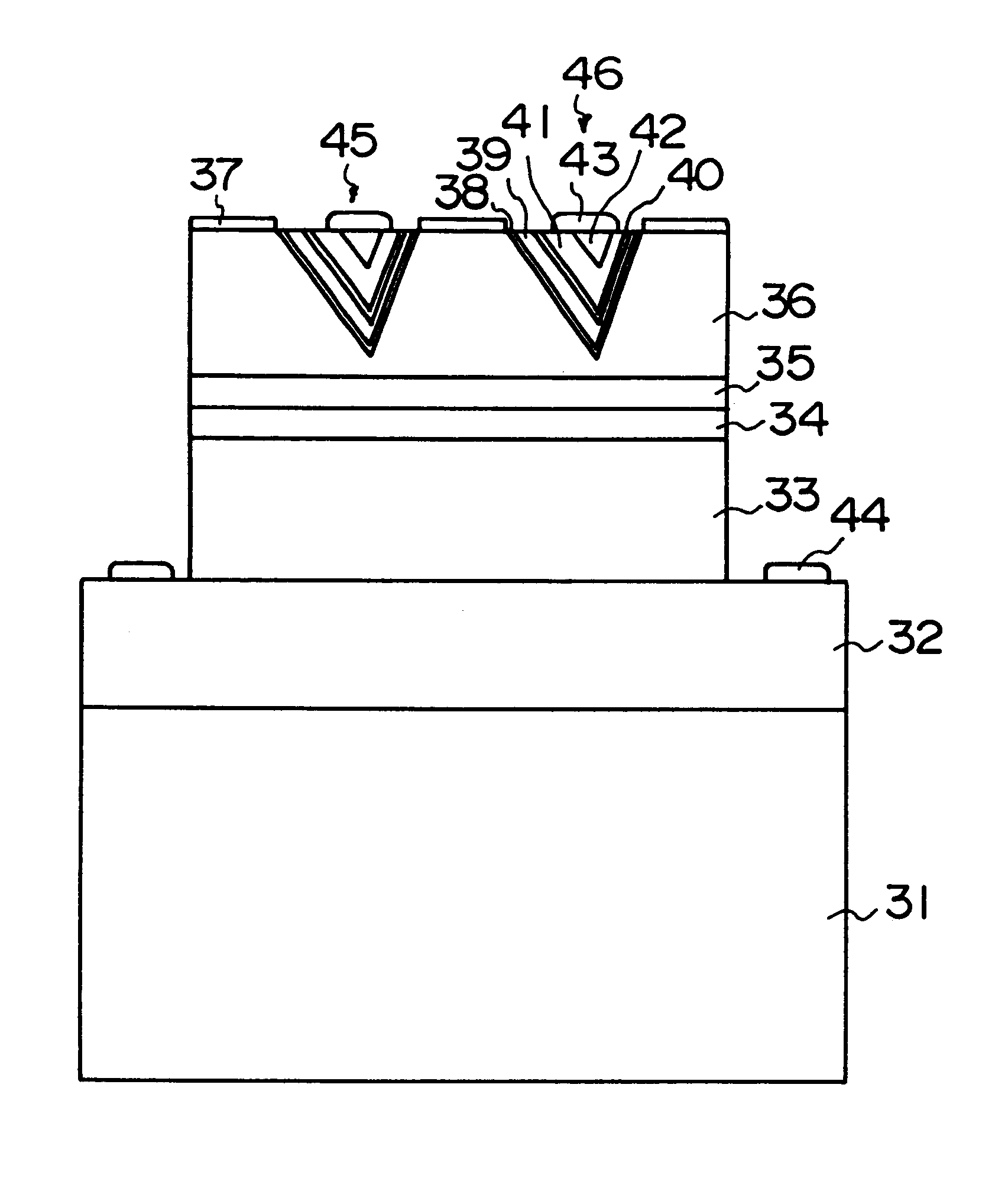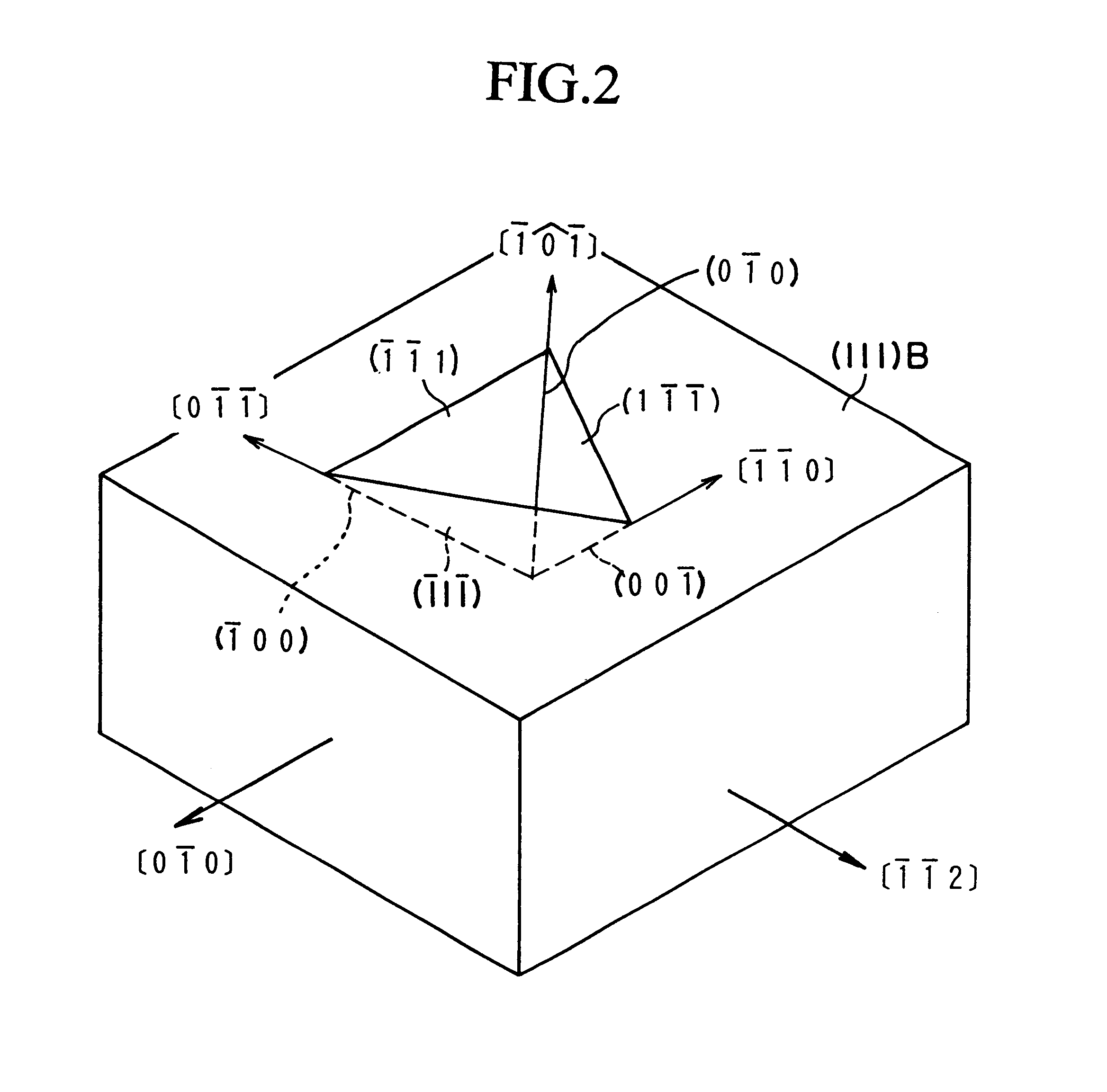Semiconductor device and method of fabricating the same
a semiconductor and device technology, applied in semiconductor devices, semiconductor lasers, laser details, etc., can solve the problems of damage to the quantum well layer 203, difficult to obtain good crystal state and good electron state, and difficult to connect the quantum box 203 to external wirings
- Summary
- Abstract
- Description
- Claims
- Application Information
AI Technical Summary
Problems solved by technology
Method used
Image
Examples
first embodiment
In this case, it should be noted that either the regular triangle shape or the circular shape, as described in the first embodiment, may be used as the etching mask opening section. In the case of the circular shape, the concave sections having the inverse regular triangular tetrahedron, which is formed to be circumscribed about the opening section, may be formed in an alignment manner.
Next, as shown in FIG. 15D, by means of the reduced pressure MOVPE method using, as a growth preventing mask, the SiO.sub.2 film 53 used as the etching mask previously, an InAlAs barrier layer 56 of a thickness of 3 nm, an InGaAs well layer 57 of a thickness of 4 nm, and an InAlAs barrier layer 58 of a thickness of 3 nm are grown in the concave section so as to trace the shape of the concave section. Thereafter, an n type InGaAs emitter layer 59 and n.sup.+ type InGaAs contact layer 60 are grown so as to bury remaining section of the concave section.
In this case, if such growth conditions (i.e., growt...
second example
With reference to FIG. 17, a second example will be explained. FIG. 17 is a sectional view of a memory cell, corresponding to FIG. 15D. Only a structure of an emitter section of the second example will be explained because a structure formed from the substrate to the base layer is the same as in the first example including the face orientation.
An Fe-doped semi-insulating InP layer 52 grown on an n type InGaAs base layer 51 is processed by anisotropic etching using an SiO.sub.2 film 53 as the mask to thus form a concave section having an inverse regular triangular tetrahedron. After this, an i type InP barrier layer 66, an i type InGaAs well layer 57, and an i type InP barrier layer 67 are grown in the concave section so as to trace the shape of the concave section. Thereafter, an n type InGaAs emitter layer 59 and an n.sup.+ type InGaAs contact layer 60 are grown so as to bury remaining section of the concave section.
In other words, in the second embodiment, the i type InAlAs barrie...
third example
With reference to FIG. 18, a third example will be explained. FIG. 18 is a sectional view of a memory cell, corresponding to FIG. 15D. Only a structure of an emitter section of the second example will be explained because a structure formed from the substrate to the base layer is the same as in the first example including the face orientation.
A p type or i type InP layer 68 is grown on an n type InGaAs base layer 51. Thereafter, the p type or i type InP layer 68 is processed by anisotropic etching using an SiO.sub.2 film 53 as the mask to thus form a concave section having an inverse regular triangular tetrahedron. After this, an i type InAlAs barrier layer 56, an i type InGaAs well layer 57, and an i type InAlAs barrier layer 58 are grown in the concave section so as to trace the shape of the concave section. Thereafter, an n type InGaAs emitter layer 59 and an n.sup.+ type InGaAs contact layer 60 are grown so as to bury remaining section of the concave section.
More particularly, i...
PUM
 Login to View More
Login to View More Abstract
Description
Claims
Application Information
 Login to View More
Login to View More - R&D
- Intellectual Property
- Life Sciences
- Materials
- Tech Scout
- Unparalleled Data Quality
- Higher Quality Content
- 60% Fewer Hallucinations
Browse by: Latest US Patents, China's latest patents, Technical Efficacy Thesaurus, Application Domain, Technology Topic, Popular Technical Reports.
© 2025 PatSnap. All rights reserved.Legal|Privacy policy|Modern Slavery Act Transparency Statement|Sitemap|About US| Contact US: help@patsnap.com



